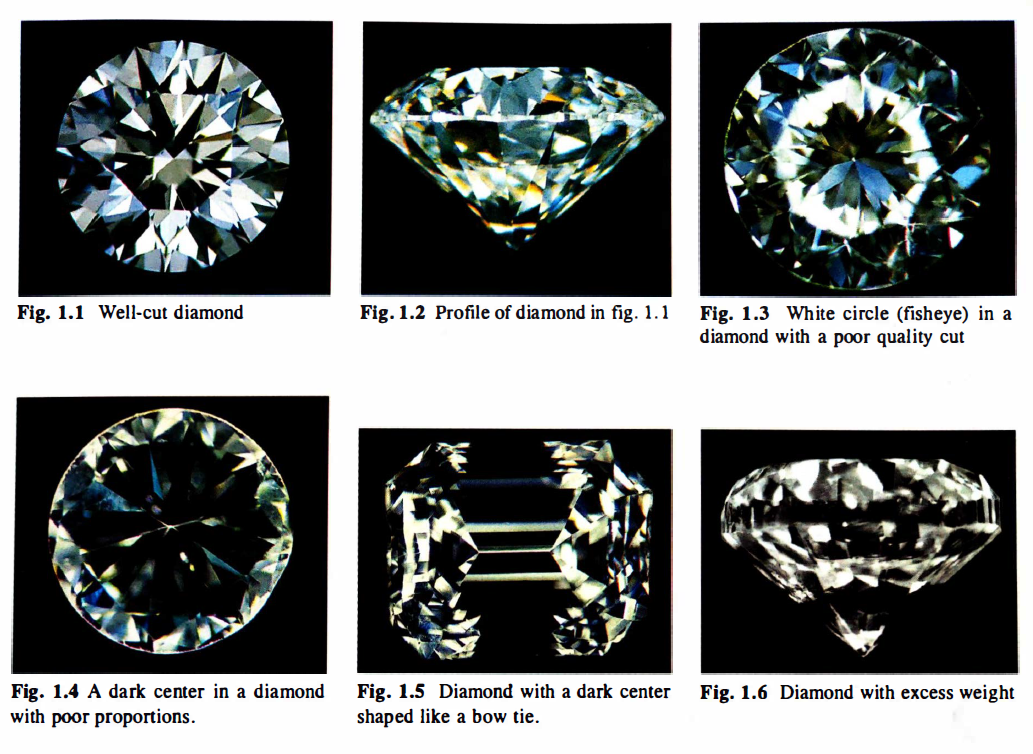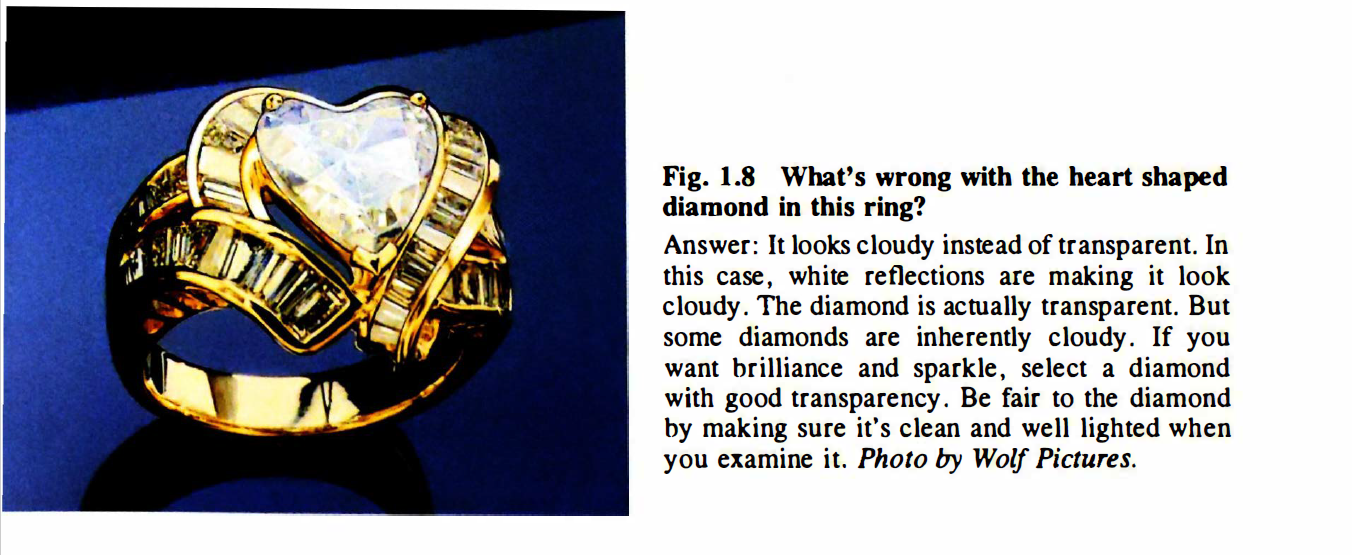In this article I will elaborate what factors are considered in pricing diamonds as mentioned previously here when we talked about 4C diamond evaluation system.
CUT QUALITY: (Proportions and finish, also called make): This is a crucial factor which can affect prices by as much as 50 % .Two of the main considerations of cut are:
1. Do you see brilliance all across the stone when you look at the diamond face up (fig. 1.1)? Diamond brilliance should not be interrupted by white circular or dark areas (figs 1.3-1.5).
2. Are you paying for excess weight? (fig. 1.6) Judge cut with the unaided eye and a 10X magnifier.

COLOR: Basically the less color, the higher the price (except for fancy colors). Stones that are as clear as colorless water are the most expensive and have a D to F rating, D being the highest. As the letters descend towards Z, more color is present. See the GIA (Gemological Institute of America) color grading scale below. Brown and gray diamonds are graded on the same scale.

A diamond is not bad quality just because ifs yellowish. Ifs simply worth less because there is a higher demand and lower supply of natural colorless diamonds. Diamonds with a natural body color other than light yellow, light brown or light gray are called fancy color diamonds. These colored diamonds may cost a lot more than those which are colorless. For example, a one-carat natural pink diamond could sell for five to fifteen times more than a D color diamond of the same size and quality.
Some diamonds are colored artificially by irradiation or high-pressure high-temperature treatment. They're worth significantly less than natural color diamonds. In the GIA system, treated colored diamonds are not considered fancy diamonds. But in the trade, they are sometimes referred to as "treated (enhanced or processed) fancy diamonds."

CARAT WEIGHT: In most cases, the higher the carat weight category, the greater the per-carat price of the diamond. A carat is a unit of weight equalling 1/5 of a gram. The weight of small diamonds is frequently expressed in points, with one point equaling 0.01 carats. There is a difference between the labels 1 ct TW (one carat total weight) and 1 ct (the weight of one stone). A ring with a 1ct top quality diamond can be worth more than 10 times as much as a ring with 1ct TW of diamonds of the same quality.
CLARITY: The fewer, smaller and less noticeable the flaws, the higher the price. There are 11 GIA clarity grades. They are:
Fl: Flawless-no inclusions (flaws inside the diamond) and no blemishes (flaws on the surface).
IF: Internally Flawless-no inclusions and only insignificant blemishes.
VVS1 & VVSz: Very, very slightly included-minute flaws difficult to see with a 1OX magnifier.
VS1 & VSz: Very slightly included-minor inclusions ranging from difficult to somewhat easy to see under 10-power magnification.
SI1 & Sl2: Slightly included, noticeable inclusions easy (SI1) or very easy (SI2) to see under 10-power magnification, but that normally aren't eye-visible.
I1, I2, & I3: Imperfect-eye-visible flaws face up that range from just visible (11 ) to extremely visible to the naked eye (I3). Some I2 and I3 diamonds may be damaged by ultrasonic cleaning. They may also be less resistant to knocks.

CUTTING STYLE & STONE SHAPE: Some shapes such as rounds cost more than others like pear shapes. The effect of shape on price depends on the stone size, demand and available supply. Brilliant-cut square diamonds (princess cuts) may cost slightly more than step-cut squares, depending on size. They have the same shape but different faceting styles.
Patented and trademarked cutting styles typically sell for more than generic cuts of the same shape. The most dramatic impact of stone shape and cutting style on price is with fancy color diamonds because their face-up color can be intensified by the shape and faceting style, and because the rough is so expensive. The price difference between some shapes can range from 10% to 100% depending on the diamonds and the dealer selling the stone.
TRANSPARENCY: Not all diamonds are transparent. Some are cloudy or translucent because they have finely divided particles which interrupt the passage of light. Normally, the higher the transparency the more valuable the diamond. Even though transparency can have a significant impact on price, lab documents do not include it as a price factor. Gem labs, however, may take it into consideration when assigning a clarity grade. Some labs identify translucent diamonds as "fancy white diamonds" and may omit a clarity grade. This terminology does not change their inherent low value.

If you 're interested in buying a brilliant diamond, choose one with high transparency. You don't need a lab report to help you do this. Your eye is the best judge of transparency. Make sure the diamonds you're comparing are clean, and be aware that transparency is an important price and beauty factor.

















































